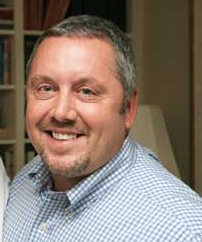Articles and News
One Great Thing I Did Last Year: Hold A Boot Camp To Teach Sales Associates Active Listening | June 03, 2015 (0 comments)

Merrick, NY—In our ongoing series titled “One Great Thing I Did Last Year (That You Can Do This Year)," The Centurion asks retailers to tell us about one outstanding thing they did in 2014 that turned out really well. This week, William ‘Bill’ Nusser (left) of Hand’s Jewelers in Iowa City, IA, shares his insight.
“One thing I did was to spend two days simply walking around my store and casually listening in on sales and other conversations that were happening on our sales floor,” said Nusser. “Business had seemed flat and the general level of excitement had inexplicably declined.” Hand explains that he and his staff believe that each customer needs to be completely satisfied after an experience in his store and he wasn’t feeling that vibe.
Nusser says, “Customer relationships are based solely on listening by the salesperson, who then uses the information gained to engage the customer in our product. We all know that listening involves so much more than simply hearing what is being said. There has to be processing, evaluation, and integrating what you're hearing. Without any information to process, there cannot be any kind of connection between you and the person on the other side of the counter. Yes/No questions do not yield more than one piece of information and often it doesn't even give you anything you want.”
So what did Nusser hear on his sleuthing mission? “I heard a lot of closed-ended questions and I heard people talking about what we can't do. Both situations preclude an excellent customer relationship.”
It was time for action. “I held a meeting to discuss my experience. I realized that everyone can intellectualize the concept of open-ended questions but when asked to put them into practice, it's not that easy. I separated people into groups of two and gave each of them a jewelry-related discussion topic and asked them to converse for three minutes, which is the time it takes to make it or break it in terms of establishing a relationship with a client.”
Nusser’s terms for this exercise were that every single response had to be open-ended. And the sales associates could use the time to rehearse only in the open-ended question format. When time was up, each group presented their conversation. The results were memorable.
“Everyone was horrified, but it was very reinforcing and the whole group was allowed to point out questions that were not open-ended questions. Next, we did groups of customer role-plays in which I had typed up fake customers all of whom were based on actual customers we have,” said Nusser. “The customer profiles included how they were to respond to yes/no questions, how much information to readily withhold and what should be held close and only be released if there were sufficient attempts to retrieve it.”
Hand even included potential detours, such as "I don't want to spend much money on this purchase," when in actuality the customer would readily splurge. All customers were based on real people.
Nusser’s objectives were simple. “The goal was to get more productive conversations going and to give people guided experience in using good questioning techniques to mine more emotionally based information from the customer. This way, the customer could and would become clear about what they wanted. Once the customer becomes clear about what it is they want, they must purchase.
“Too many salespeople believe that they have to find out what the customer wants, which is only part of the puzzle. Helping the customer become clear about what they want is the real point of success and that cannot be done unless the salesperson can understand and re-convey a customer's purchase motivation. It's all accomplished through skillful questioning and excellent listening skills.”
Nusser also addressed the “can’t do” comments. “I told the staff in a separate, very short meeting that I had heard too much focus on what we could not do. So I issued a rare edict and that was that no salesperson could say ‘no’ to a customer; only I could. So, if they were to have to tell a customer that we were unable to do something for them, it had to come from me, not them, and that I would be listening. This forced them to, once again, use questioning to avoid having to bring me into a situation of turning down a job. In other words, they were focusing on the possibilities rather than the impossibilities.”
The retraining and new procedures have made a difference in the sales and customer experience at Hand’s Jewelers, according to Nusser. “The moral of both stories is that customers are willing and able to give you information that is incredibly valuable. The initial skill is listening, particularly the processing part of listening. In order to be able to listen well, the use of productive questions in both the relationship building and probing phases of the jewelry sales transaction is essential!”
Nusser admits to still monitoring conversations in the store from time to time. His bottom line? “It is easy to slip out of asking the good questions and wonder why your customer isn't responding. Tweaking is far easier than changing.”
Click to view other "One Great Thing" stories in our series:
- Rethink Your Store Hours
- Hire Help For The Busywork
- Handwrite Invitations
- Update Your Store's Atmosphere
- Build More Community Relationships
- Optimize Your Inventory System
- 'Your Repair Is Ready' Phone Calls
- Facebook Engagement Photos (With Permission)
- Fundraising For Your Local Community
- Get Social With Facebook and Instagram
- Help Your Community Celebrate The Holidays
- Design a Locally Relevant, Salable Jewelry Line
- Traveling Jewelry Clinics







